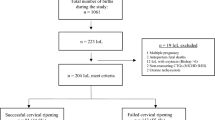Abstract
Purpose
The aim of this multicentric study is to compare clinical, biophysical and molecular parameters in the prediction of the success of labour induction with prostaglandins.
Methods
We included 115 women, who underwent to labour induction at term with vaginal prostaglandin gel. We evaluated the diagnostic efficiency of endocervical phosphorylated insulin-like growth factor-binding protein (phIGFBP-1), cervicovaginal interleukins 6 (IL-6) and 8 (IL-8). We analyzed the transvaginal sonographic measurement of cervical length. A receiver-operating characteristics (ROC) curve was used to determine the most useful cut-off point. A multivariate logistic regression model was used to analyze the combination of significant predictive variables following univariate analysis. We analyzed all the data searching for the parameters that best predict the beginning of the active phase of labour within 12 h.
Results
36.5 % of the patients delivered within 12 h. The Bishop score was >4 in the 43 % of patients with an active phase. The best cut-off values at ROC curves for cervical length, IL-6 and IL-8 were respectively 22 mm, 5 mg/dl and 20,237 mg/dl. At univariate analysis, all predictors of success, with the exception of IL-6, were significantly associated with the beginning of the active phase. Multivariate analysis of the Bishop score (OR 2.3), phIGFBP-1 test (OR 11.2) and IL-8 (OR 6.6) showed that the variables were independent and therefore useful in combination to predict the success of labour induction.
Conclusion
The phIGFBP-1 test is a fast and easy test that can be used with Bishop score and IL-8 to reach an high positive predictive value in the prediction of the success of labour induction with prostaglandins.



Similar content being viewed by others
Abbreviations
- phIGFBP-1:
-
Phosphorylated insulin-like growth factor-binding protein
- IL:
-
Interleukin
- PPV:
-
Positive predictive value
- NPV:
-
Negative predictive value
- NS:
-
Not significant
- OR:
-
Odds ratio
References
Cunningham GF, Gant NF, Leveno KJ et al (2001) Williams’ obstetrics. McGraw-Hill Medical Publishing Division, New York, pp 470–471
Goffinet F, Humbert R, Clerson P et al (1999) National survey on the use of induced labour by ostetricians. Study groups on induced labour. J Gynecol Obstet Biol Reprod 28:319–329
American College of Obstetricians and Gynecologists (1999) Induction of labour. Practice Bulletin, The College, Washington DC
Berland M (1997) Induzione artificiale del travaglio. Ginecologia-Ostetricia Encycl Méd Chir (Elsevier, Parigi), Amsterdam
Bishop EH (1964) Pelvic scoring for elective induction. Obstet Gynecol 24:266–268
Watson WJ, Stevens D, Welter S, Day D (1996) Factors predicting successful labour induction. Obstet Gynecol 88:990–992
Reis FM, Gervasi MT, Florio P et al (2003) Prediction of successful induction of labor at term: role of clinical history, digital examination, ultrasound assessment of the cervix and fetal fibronectin assay. Am J Obstet Gynecol 189:1361–1367
Rozenberg P, Goffinet F, Hessabi M (2000) Comparison of the Bishop score, ultrasonographically measured cervical length and fetal fibronectin assay in predicting until delivery and type of delivery at term. Am J Obstet Gynecol 182:108–113
Rozenberg P, Chevret S, Ville Y (2005) Comparison of preinduction ultrasonographic cervical length and Bishop score in predicting risk of cesarean section after labor induction with prostaglandins. Gynécol Obstétr Fertil 33:17–22
Roman H, Verspyck E, Vercoustre L et al (2004) The role of ultrasound and fetal fibronectin in predicting the length of induced labor when the cervix is unfavourable. Ultrasound Obstet Gynecol 23:567–573
Garite TJ, Casal D, Garcia Alonso A (1996) Fetal fibronectin: a new tool for the prediction of successful induction of labor. Am J Obstet Gynecol 175:1516–1521
Blanch G, Olah KSJ, Walkinshaw S (1996) The presence of fetal fibronectin in the cervicovaginal secretions of women at term: its role in the assessment of women before labor induction and in the investigation of the physiologic mechanisms of labor. Am J Obstet Gynecol 174:262–266
Ojutiku D, Jones G, Bewley S (2002) Quantitative fetal fibronectin as a predictor of successful induction of labour in post-date pregnancies. Eur J Obstet Gynecol Reprod Biol 101:143–146
Imai M, Tani A, Saito M et al (2001) Significance of fetal fibronectin and cytokine measurement in the cervicovaginal secretions of women at term in predicting term labor and post-term pregnancy. Eur J Obstet Gynecol Reprod Biol 97:53–58
Nuutila Mika, Hiilesmaa V, Karkkainen T, Ylikorkala O, Rutanen EM (1999) Phosphorylated isoforms of insulin-like growth factor binding protein-1 in the cervix as a predictor of cervical ripeness. Obstet Gynecol 94:243–249
Crane JM (2006) Factors predicting labor induction success: a critical analysis. Clin Obstet Gynecol 49:573–584
Lange AP, Secher NJ, Westgaard JG, Skovgard AI, Stat C (1982) Prelabour evaluation of inducibility. Obstet Gynecol 60:137–147
Gonen R, Degani S, Ron A (1998) Prediction of successful induction of labor: comparison of transvaginal ultrasonography and the Bishop score. Eur J Ultrasound 7:183–187
Yang SH, Roh CR, Kim JH (2004) Transvaginal ultrasonography for cervical assessment before induction of labor. J Ultrasound Med 23:375–382
Rane SM, Guirgis RR, Higgins B, Nicolaides KH (2004) The value of ultrasound in the prediction of successful induction of labor. Ultrasound Obstet Gynecol 24:538–539
Bartha JL, Romero-Carmona R, Martinez- Del Fresno P, Comino-Delgado R (2005) Bishop score and transvaginal ultrasound for preinduction cervical assessment: a randomized clinical trial. Ultrasound Obstet Gynecol 25:155–159
Bueno B, San-Frutos I, Perez-Medina T, Barbancho C, Trovano J, Bajo J (2007) The labor induction: integrated clinical and sonographic variables that predict the outcome. J Perinatol 27:4–7
Rizzo G, Capponi A, Rinaldo D, Tedeschi D, Arduini, Romanini C (1996) Interleukins-6 concentrations in cervical secretions identify microbial invasion of the amniotic cavity in patients with preterm labour and intact membranes. Am J Obstet Gynecol 175:812–817
Conflict of interest
None.
Author information
Authors and Affiliations
Corresponding author
Rights and permissions
About this article
Cite this article
Riboni, F., Garofalo, G., Pascoli, I. et al. Labour induction at term: clinical, biophysical and molecular predictive factors. Arch Gynecol Obstet 286, 1123–1129 (2012). https://doi.org/10.1007/s00404-012-2432-1
Received:
Accepted:
Published:
Issue Date:
DOI: https://doi.org/10.1007/s00404-012-2432-1




